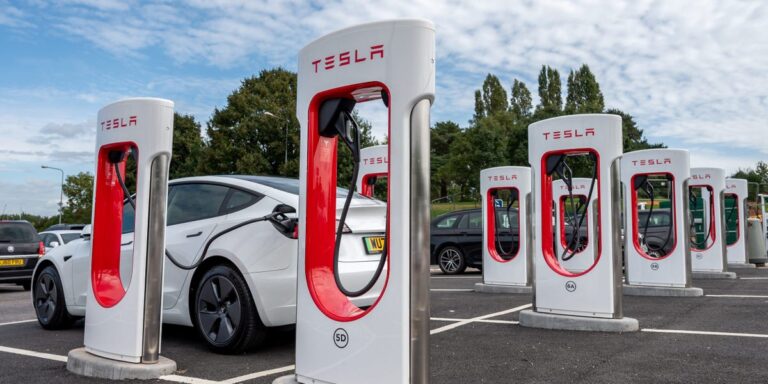- Ukrainians are turning to Tesla to power their homes amid rolling blackouts.
- Some are repurposing old Tesla batteries, while others are going even further.
- This comes as the country adapts to rolling blackouts caused by Russia’s targeting of its energy grid.
Ukrainians are turning to Tesla to help power their homes and limit the impact of Russian attacks on energy infrastructure, according to a report in the Financial Times.
A Ukrainian entrepreneur who reuses Tesla batteries told the FT that one Tesla can be used to make up to 12 battery systems.
“An old Tesla, including shipping costs, will cost almost $10,000. And you can convert it into 12 batteries, and also sell the spare parts,” said Oleksandr Bentsa, who for years has been buying damaged Teslas from the US and repairing them and reselling them in Ukraine.
The five-kilowatt-hour (kWh) system his company built produces enough energy to power the lights and appliances in a standard apartment for 10 hours, the report said.
However, Bentsa’s new idea may have been trumped by his father, who has connected his entire house to a Tesla parked in his driveway, according to the FT.
Its 100 kWh battery can power an entire home for a week, Bentsa says.
Bentsa told the outlet that he now expects sales to increase as winter approaches.
Rolling power outages in Ukraine have raised major concerns ahead of winter.
The Kyiv Independent reports that the CEO of Ukrainian energy supplier Yasno, Serhiy Kovalenko, said in June that local residents might only face six or seven hours of electricity a day in winter if the electricity deficit reaches 35%.
However, countries such as Moldova and Poland are looking at ways to help Ukraine increase its electricity supply, with the latter considering a plan that would involve burning fuel in Poland and shipping it to Ukraine, Polish Prime Minister Donald Tusk said this month, according to Bloomberg.
“At least it will help Ukraine survive the winter,” Tusk said.
The power outage in Ukraine was caused by Russian bombing of Ukraine’s energy grid.
Russia stepped up its efforts to disrupt energy grids in the spring in hopes of breaking Ukraine’s resolve to continue fighting, particularly targeting energy generation infrastructure.
Neil Holland, head of the UK Delegation to the Organisation for Security and Co-operation in Europe (OSCE), said earlier this month that Russian attacks since the spring had resulted in a total loss of more than 9 GW of electricity.
In June, Russia launched a “massive” attack on Ukraine’s power grid in what Ukraine’s energy ministry said was the eighth major attack on the country’s energy infrastructure since March.
“We must immediately close the airspace or Ukraine will face a serious crisis this winter,” Maxim Timchenko, CEO of Ukrainian energy company DTEK, said after the attack, according to the BBC. “My appeal to the allies is to help us maintain our energy system and rebuild it in time.”
Ukrainian officials, including the country’s president, Volodymyr Zelenskyy, have also pleaded with allies to upgrade air defense systems to help counter such attacks.
But Ukraine also struck back at Russian energy sites, particularly Russian oil refineries.
Earlier this year, the US urged Ukraine to halt the attacks amid concerns that they would cause a spike in oil prices and potentially trigger further action from Russia.
However, Ukraine has signaled that it will not stop the attacks, saying the oil refinery is a legitimate military target.


